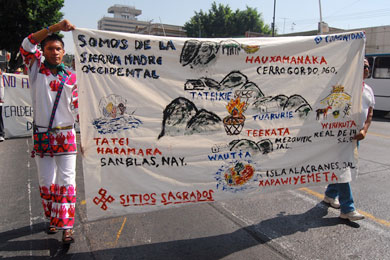With their ancestral homeland in danger of destruction at the hands of a Canadian mining company, the indigenous Huichol people used their annual pilgrimage to stage a rally in defense of their sacred territory last week.
 Counting on support from their gods (as well as local media and human rights organizations), the Wixaritari, as the Huichol people traditionally call themselves, embarked upon a spiritual and political journey with the aim of drawing national attention to their predicament.
Counting on support from their gods (as well as local media and human rights organizations), the Wixaritari, as the Huichol people traditionally call themselves, embarked upon a spiritual and political journey with the aim of drawing national attention to their predicament.
Mexico’s 28,000 Wixaritari are natives of a mountainous area where northern Jalisco, eastern Nayarit, southern Durango and western Zacatecas all intersect. They originated in Wirikuta, the Huichol name for Cerro del Quemado, in Real de Catorce, San Luis Potosi. This is a sacred area for the Wixaritari, where it is said the Sun God, “Tao Jreeku,” created the world.
Every year, hundreds of Wixaritari walk almost 500 kilometers to Wirikuta to pray, leave religious offerings and perform “Mitote” ceremonies with peyote, the sacred hallucinogenic cactus. Considered a magical means of communicating with the gods, peyote is an important part of Wixaritari culture and only they are legally allowed to gather or possess the cactus.
This year 800 pilgrims left their communities at the beginning of the month, arriving en masse on February 6. Normally the separate communities from different states arrive apart, but this year they coordinated their pilgrimages so as to arrive together and draw greater attention.
Attended by numerous special guests – including representatives of the United Nations High Commissioner, musicians, journalists and dozens of notable non-governmental organizations and human rights groups – the event was intended to protest the Mexican government’s decision to allow a Canadian mining company to exploit the area.
In November 2009, Vancouver-based First Majestic Silver Corporation bought 22 concessions from the Mexican government to explore and develop mineral deposits in a 6,327-hectare area of the Real de Catorce region. Around 70 percent of the land falls inside the sacred Wirikuta area.
Please login or subscribe to view the complete article.

